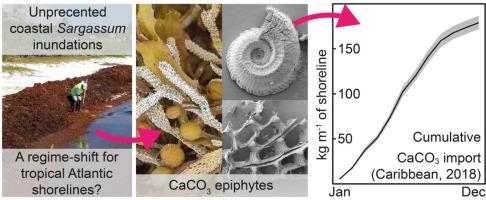当前位置:
X-MOL 学术
›
Glob. Planet. Change
›
论文详情
Our official English website, www.x-mol.net, welcomes your
feedback! (Note: you will need to create a separate account there.)
Pelagic Sargassum as an emerging vector of high rate carbonate sediment import to tropical Atlantic coastlines
Global and Planetary Change ( IF 4.0 ) Pub Date : 2020-12-01 , DOI: 10.1016/j.gloplacha.2020.103332 Michael A. Salter , Rosa E. Rodríguez-Martínez , Lorenzo Álvarez-Filip , Eric Jordán-Dahlgren , Chris T. Perry
Global and Planetary Change ( IF 4.0 ) Pub Date : 2020-12-01 , DOI: 10.1016/j.gloplacha.2020.103332 Michael A. Salter , Rosa E. Rodríguez-Martínez , Lorenzo Álvarez-Filip , Eric Jordán-Dahlgren , Chris T. Perry

|
Abstract Since 2011, pelagic Sargassum has inundated Caribbean, West African, and northern Brazilian shorelines in increasing volumes. These events are linked to the emergence of a major new Sargassum bloom region in the Atlantic Ocean, and annual high-volume Sargassum beachings are seemingly becoming an established norm. Resultant socio-economic and ecological implications are widespread and potentially serious, but an important question that has so far received no attention is whether these Sargassum inundations might represent a new source of carbonate sediment in affected coastal areas. This sediment derives from calcareous epiphyte communities that colonise Sargassum (e.g., bryozoans, serpulid worms, and red algae), and if volumetrically significant, may help to counteract aspects of Sargassum beachings thought to reduce sediment supply and decrease coastal stability. Here we determine the carbonate contents of Sargassum from coastal waters of the Mexican Caribbean. Integrating these with volumetric data on beached Sargassum, we then estimate total epiphytic carbonate import during 2018 at 11 sites along a 60 km section of the Quintana Roo coast, Mexico. Based on measured mean carbonate content of Sargassum (2.09% wet weight; 95% confidence interval [CI]: 1.83–2.32), and estimates of annual beached Sargassum (7.0 × 103 kg drained weight·m−1 of shoreline; 95% CI: 6.9–7.2), our findings indicate that Sargassum beachings in the Mexican Caribbean contributed an average of 179 kg CaCO3·m−1 of shoreline (95% CI: 173–185) in 2018: close to our upper estimate of seagrass epiphyte contributions (210 kg·m−1). Although quantitative data on Sargassum beachings from other locations are sparse, numerous media reports suggest the scale of these events is comparable for many exposed tropical Caribbean and Atlantic shorelines. This represents the first documentation of pelagic Sargassum as a major vector of coastal sediment import, the significance of which has likely only arisen since the onset of large-scale inundations in 2011.
中文翻译:

远洋马尾藻作为高速率碳酸盐沉积物输入热带大西洋海岸线的新兴载体
摘要 自 2011 年以来,远洋马尾藻越来越多地淹没加勒比海、西非和巴西北部海岸线。这些事件与大西洋上一个主要的新马尾藻爆发区的出现有关,每年大量的马尾藻搁浅似乎已成为一种既定的规范。由此产生的社会经济和生态影响是广泛且潜在的严重问题,但迄今为止尚未受到关注的一个重要问题是,这些马尾藻淹没是否可能代表受影响沿海地区碳酸盐沉积物的新来源。这种沉积物来自定殖于马尾藻的钙质附生植物群落(例如苔藓虫、蛇类蠕虫和红藻),如果体积显着,可能有助于抵消被认为减少沉积物供应和降低沿海稳定性的马尾藻搁浅的方面。在这里,我们确定了来自墨西哥加勒比海沿岸水域的马尾藻的碳酸盐含量。将这些与搁浅马尾藻的体积数据相结合,然后我们估计了 2018 年墨西哥金塔纳罗奥海岸 60 公里部分沿线 11 个地点的附生碳酸盐进口总量。基于测量的马尾藻平均碳酸盐含量(2.09% 湿重;95% 置信区间 [CI]:1.83–2.32)和年度搁浅马尾藻的估计值(7.0 × 103 kg 排水重量·m-1 海岸线;95% CI : 6.9–7.2),我们的研究结果表明,2018 年墨西哥加勒比海的马尾藻海滩平均贡献了 179 kg CaCO3·m-1 的海岸线(95% CI:173–185):接近我们对海草附生植物贡献的上限估计 (210 kg·m-1)。尽管来自其他地方的马尾藻搁浅的定量数据很少,但许多媒体报道表明,这些事件的规模与许多暴露的热带加勒比海和大西洋海岸线相当。这是首次将远洋马尾藻作为沿海沉积物输入的主要载体的首次记录,其重要性可能自 2011 年大规模洪水开始以来才出现。
更新日期:2020-12-01
中文翻译:

远洋马尾藻作为高速率碳酸盐沉积物输入热带大西洋海岸线的新兴载体
摘要 自 2011 年以来,远洋马尾藻越来越多地淹没加勒比海、西非和巴西北部海岸线。这些事件与大西洋上一个主要的新马尾藻爆发区的出现有关,每年大量的马尾藻搁浅似乎已成为一种既定的规范。由此产生的社会经济和生态影响是广泛且潜在的严重问题,但迄今为止尚未受到关注的一个重要问题是,这些马尾藻淹没是否可能代表受影响沿海地区碳酸盐沉积物的新来源。这种沉积物来自定殖于马尾藻的钙质附生植物群落(例如苔藓虫、蛇类蠕虫和红藻),如果体积显着,可能有助于抵消被认为减少沉积物供应和降低沿海稳定性的马尾藻搁浅的方面。在这里,我们确定了来自墨西哥加勒比海沿岸水域的马尾藻的碳酸盐含量。将这些与搁浅马尾藻的体积数据相结合,然后我们估计了 2018 年墨西哥金塔纳罗奥海岸 60 公里部分沿线 11 个地点的附生碳酸盐进口总量。基于测量的马尾藻平均碳酸盐含量(2.09% 湿重;95% 置信区间 [CI]:1.83–2.32)和年度搁浅马尾藻的估计值(7.0 × 103 kg 排水重量·m-1 海岸线;95% CI : 6.9–7.2),我们的研究结果表明,2018 年墨西哥加勒比海的马尾藻海滩平均贡献了 179 kg CaCO3·m-1 的海岸线(95% CI:173–185):接近我们对海草附生植物贡献的上限估计 (210 kg·m-1)。尽管来自其他地方的马尾藻搁浅的定量数据很少,但许多媒体报道表明,这些事件的规模与许多暴露的热带加勒比海和大西洋海岸线相当。这是首次将远洋马尾藻作为沿海沉积物输入的主要载体的首次记录,其重要性可能自 2011 年大规模洪水开始以来才出现。










































 京公网安备 11010802027423号
京公网安备 11010802027423号